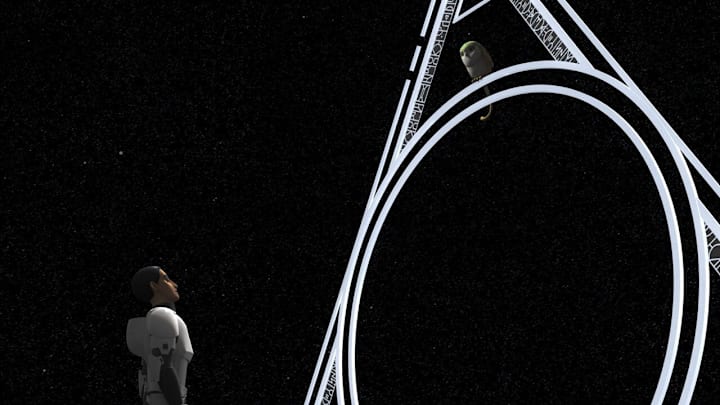As the ten-year anniversary of Star Wars Rebels approaches, fans of the show must stop and appreciate something very special, an unprecedented new addition to the Star Wars universe: The Vergence Scatter, also known as the World Between Worlds.
This strange location in the galaxy far, far away seemed an odd addition to the Star Wars universe back then, and it does even now. However, George Lucas himself had a hand in Star Wars Rebels and approved it as Dave Filoni and Henry Gilroy developed the idea. So, above all else, we must consider it a window into his thoughts about the mysticality behind the Star Wars universe, his thoughts about the Force, and the origins of the galaxy itself.
Peering Beyond Death in Star Wars
What’s unprecedented about the World Between Worlds is that it’s the first time we’ve been allowed to peer beyond death in the Star Wars universe and directly into the mysteries of the Force.
It’s a sign of meticulous world-building when the characters' religions in a fictional universe are so well thought out that we even see beyond death in that world. So, it’s interesting to behold the various similarities the World Between Worlds has to some religious cosmologies here on Earth. Did Lucas, Filoni, and Gilroy intend for the World Between Worlds to mimic ideas many have about death and the purpose of life here on this planet?
Jewish actress Natalie Portman has said, "I don't believe in the afterlife. I believe this is it, and I believe it's the best way to live." But many of the world’s religions believe in life after death and that in death, one passes through a place, much like the World Between Worlds, on one’s way somewhere else to plan our next life.
Hinduism teaches that our souls have separated from one supreme or absolute soul and that we undergo a journey of learning lessons throughout various lives as we work our way back to the absolute soul. This is analogous to the Cosmic vs. the Living Force dichotomy that Qui-Gon Jinn speaks about. Buddhism, Jainism, and Sikhism also teach these concepts. In addition, most astrologers claim to see this in the birth chart, and many tarot readers subscribe to this belief. It’s a tenet of New Age thinking, as well.
According to these schools of thought and many people who claim to have had near-death experiences, after death, the soul returns to a Heaven-like place by means of a tunnel toward which one is drawn by a bright light. This would be analogous to the paths we see in the World Between Worlds, which we assume lead to this destination, where one would experience such things as a life review and planning one’s next life in New Age and Eastern religions.
Of course, we never see in the Star Wars universe where the paths through the World Between Worlds end… or, at least, we haven’t yet. But the fact that they exist means they must lead somewhere, which is incongruous with the idea, standard in Star Wars lore, that all souls rejoin the Cosmic Force when they die. There are some exceptions with Jedi, such as Qui-Gon Jinn, who have discovered and taught other Jedi how to avoid this and reappear to those still a part of the Living Force through being Force ghosts.
Along the many paths we see in the World Between Worlds, what draw the eye and ear are the portals that are seen, together with the familiar voices and sounds that call out to characters who have a near-death experience or fall into the World unexpectedly, such as Ahsoka Tano and Ezra Bridger. Lord Sidious desires to use these portals to change history, which implies that these portals lead to other choices that could have been made in a character’s life and a parallel universe that could have been ... or perhaps is, in a different reality.
These, too, have real-world analogs, at least in astrology and New Age thought. I, myself, as a student astrologer, have studied transits in people’s charts that reflect alternate paths these people could have taken in life. Most fascinating of all, modern science has also speculated about the existence of parallel universes.

Where It Doesn't Make Sense
However, discrepancies exist. The structure of the World Between Worlds has paths that appear to lead someplace we haven’t yet seen. And the fact that in Star Wars: The Rise of Skywalker, both speaking and fighting on the sides of Rey and Palpatine are Jedi and Sith who are deceased, haven’t appeared as Force ghosts, and are supposed to have dissolved into the Cosmic Force. Or, in the case of Sith, ended up in irredeemable chaos.
These details present conflicting information to the discerning Star Wars fan. Will the Star Wars afterlife, the Star Wars cosmology, and how it all is really supposed to work ever be straightened out?
Perhaps and perhaps not, but the overall effect of the World Between Worlds over these past ten years is that we have this new and mystical aspect of the Star Wars galaxy to turn over in our minds and contemplate. We have a nifty new origin myth in the Mortis Gods as they appeared on the walls of the Temple at Lothal.
And, without the World Between Worlds, we would never have had the satisfying conclusion to Anakin’s relationship with his old Padawan, which we recently got to see and enjoy in Ahsoka.
Perhaps the World Between Worlds isn’t supposed to make sense. Perhaps its true value is to stimulate the imagination and inspire wonder… as all of Star Wars has for almost fifty years now.
